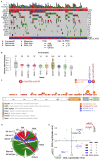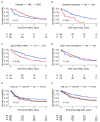Genetic landscape and clinical outcomes of patients with BCOR mutated myeloid neoplasms
- PMID: 38299584
- PMCID: PMC11141657
- DOI: 10.3324/haematol.2023.284185
Genetic landscape and clinical outcomes of patients with BCOR mutated myeloid neoplasms
Abstract
The BCL6-corepressor (BCOR) is a tumor-suppressor gene located on the short arm of chromosome X. Data are limited regarding factors predicting survival in BCOR-mutated (mBCOR) acute myeloid leukemia (AML) and myelodysplastic syndrome (MDS). We evaluated 138 patients with mBCOR myeloid disorders, of which 36 (26.1%) had AML and 63 (45.6%) had MDS. Sixty-six (47.8%) patients had a normal karyotype while 18 (13%) patients had complex karyotype. BCOR-mutated MDS/AML were highly associated with RUNX1 and U2AF1 co-mutations. In contrast, TP53 mutation was infrequently seen with mBCOR MDS. Patients with an isolated BCOR mutation had similar survival compared to those with high-risk co-mutations by European LeukemiaNet (ELN) 2022 criteria (median OS 1.16 vs. 1.27 years, P=0.46). Complex karyotype adversely impacted survival among mBCOR AML/MDS (HR 4.12, P<0.001), while allogeneic stem cell transplant (alloSCT) improved survival (HR 0.38, P=0.04). However, RUNX1 co-mutation was associated with an increased risk of post-alloSCT relapse (HR 88.0, P=0.02), whereas melphalan-based conditioning was associated with a decreased relapse risk (HR 0.02, P=0.01). We conclude that mBCOR is a high-risk feature across MDS/AML, and that alloSCT improves survival in this population.
Figures





Comment in
-
Be aware of the X: BCOR mutations in myeloid neoplasms.Haematologica. 2024 Jun 1;109(6):1646-1647. doi: 10.3324/haematol.2023.284748. Haematologica. 2024. PMID: 38328862 Free PMC article. No abstract available.
References
-
- Grossmann V, Tiacci E, Holmes AB, et al. . Whole-exome sequencing identifies somatic mutations of BCOR in acute myeloid leukemia with normal karyotype. Blood. 2011;118(23):6153-6163. - PubMed
-
- Döhner H, Wei AH, Appelbaum FR, et al. . Diagnosis and management of AML in adults: 2022 recommendations from an international expert panel on behalf of the ELN. Blood. 2022;140(12):1345-1377. - PubMed
Publication types
MeSH terms
Substances
LinkOut - more resources
Full Text Sources
Medical
Research Materials
Miscellaneous

